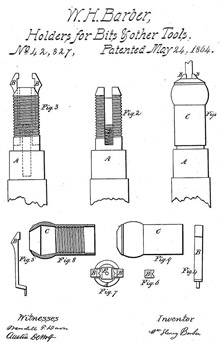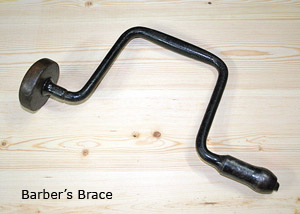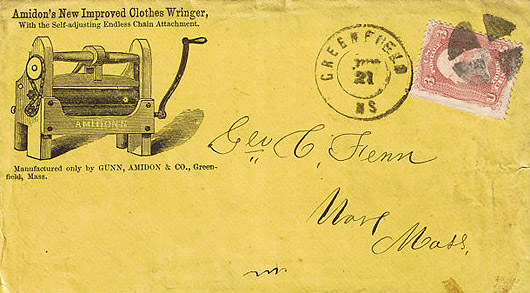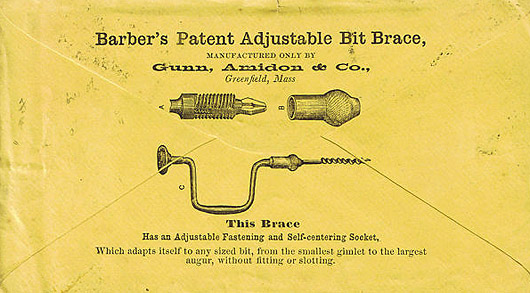It would be only a speculation to assume that the deal
to purchase Barber's patent was struck right there
and then, but the fact is that Gunn & Amidon began
production of bit braces in 1864.
Although the
patent was not assigned to "Gunn & Amidon", it is
generally assumed
that the deal included exclusive use of the patent,
production rights and use of Barber's name. On
February 6, 1872 however, the patent was reissued under
No. 4,736 and the Millers Falls Mfg. Co. reestablish
itself as an assignee, by mesne assignment, for
Barber's patent. Second reissue on August 15, 1876
confirmed Millers Falls Company as an assignee of the
patent.
Today, some believe that Gunn and Amidon did not fully
understand the significance of the Barber's design and
it was more or less a lucky choice that guided them in this
purchase. However, aside from luck, and considering Gunn's and Amidon's
experience in tools production and unquestionable genius
of Amidon in tools design, I believe it was conscious
decision and both partners understood from the beginning
the importance of Barber's patent.
William Henry Barber received his patent on May 24, 1864
under No. 42,827. In his invention description
Barber said in part:
"Be it known that I, William Henry Barber, of
Greenfield, in the county of Franklin and State of
Massachusetts, have invented a new and useful instrument
for holding bits and other tools securely without
fitting the same to the holder; and I do hereby declare
that the following is a full, clear and exact
description of the construction and operation of the
same, reference being had to the annexed drawing."
 The ingenuity of the design rests in its
simplicity and ability to accept bits with tapered square
shank of various sizes. These sound like a bottom-line
requirements but closer look will help understand Barber's
solution.
The ingenuity of the design rests in its
simplicity and ability to accept bits with tapered square
shank of various sizes. These sound like a bottom-line
requirements but closer look will help understand Barber's
solution.
He described it as follows: "The
instrument or holder consists of center piece, (marked A,) two
jaws, (Marked B and B,) a screw or nut, (marked C,) and a spiral
spring, (marked D.)"
First, the chuck consisted of only 4 parts: a
threaded shell, 2 jaws and a spring. After these parts
were produced, the assembly required no special skills or
equipment and could be performed by any worker or apprentice.
Second, at the time, the most popular bits were
made with tapered square shanks. They were made by wide
variety of producers, from small village blacksmith shops to
small and larger machine shops to larger production enterprises.
However, no standard existed and due to variety of production
methods and skills, the shanks were not exactly the same in size
and shape. Quite often the bit and brace users had to
custom-fit shanks to the chuck by filing and shaping them.
Barber's chuck was flexible and did not required shanks of the
same exact size.
By 1865 production of bit braces was in full swing.
The choice made
by Gunn and Amidon was an instant success and positioned the
company well in the boring tools market.
This early investment propelled them into tool making
business.


Envelope used by the Gunn, Amidon & Co. for
promotion of their core products.
 Amidon immediately began experiments with his own chuck
design and on October 3, 1865 received patent No. 50,214
for Improvement in Bit-stock. He described his
invention as follows:
Amidon immediately began experiments with his own chuck
design and on October 3, 1865 received patent No. 50,214
for Improvement in Bit-stock. He described his
invention as follows:
"The nature of my invention consists in providing a
bit-stock with a movable socket-block to hold the head
of the bit from turning in the stock, in combination
with a pair of movable jaws to grip the shank of the
bit, and a screw-nut or sleeve to operate both socket
and jaws at one operation, thereby securing not only
great facility of action, but greater steadiness and
truth than is commonly attained."